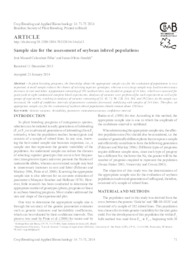Sample size for the assessment of soybean inbred populations.
Sample size for the assessment of soybean inbred populations.
Author(s): COLOMBARI FILHO, J. M.; GERALDI, I. O.
Summary: In plant breeding programs, the knowledge about the appropriate sample size for the evaluation of populations is very important. A small sample reduces the chance of selecting superior genotypes, whereas a very large sample may lead to unnecessary increases in cost and labor. A population consisting of 192 soybean lines was divided in groups of 24 lines, which were assessed for grain yield in eight randomized complete block experiments. Analyses of variance were performed for each experiment as well as for groups of experiments, resulting in analyses of variance consisting of 24, 48, 72, 96, 120, 144, 168, and 192 lines. As the sample size increased, the width of confidence intervals of parameter estimates decreased, stabilizing with samples of 144 lines. Therefore, an appropriate sample size for the evaluation of soybean inbred populations should contain about 150 lines.
Publication year: 2014
Types of publication: Journal article
Unit: Embrapa Rice & Beans
Observation
Some of Embrapa's publications are published as ePub files. To read them, use or download one of the following free software options to your computer or mobile device. Android: Google Play Books; IOS: iBooks; Windows and Linux: Calibre.
Access other publications
Access the Agricultural Research Database (BDPA) to consult Embrapa's full library collection and records.
Visit Embrapa Bookstore to purchase books and other publications sold by Embrapa.

